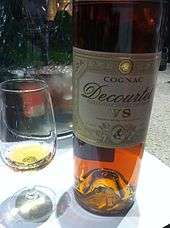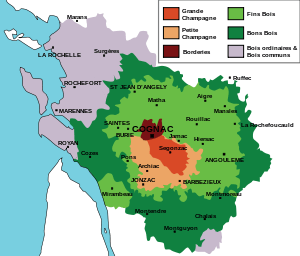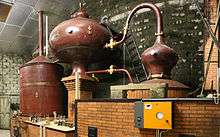Cognac
Cognac (/ˈkɒnjæk/ KON-yak, also US: /ˈkoʊn-, ˈkɔːn-/ KOHN-, KAWN-,[2][3][4] French: [kɔɲak] (![]()
| Type | Brandy |
|---|---|
| Country of origin | France |
| Region of origin | Nouvelle-Aquitaine |
| Alcohol by volume | 40% |
| Flavour | Varies, though typically with characteristics combining nuts, fruit, caramel, honey, vanilla or other spices[1] |
| Variants | VS, VSOP, XO |
| Related products | Armagnac, Vinjak |
| Website | cognac |
Cognac production falls under French appellation d'origine contrôlée designation, with production methods and naming required to meet certain legal requirements. Among the specified grapes, Ugni blanc, known locally as Saint-Emilion, is most widely used.[5] The brandy must be twice distilled in copper pot stills and aged at least two years in French oak barrels from Limousin or Tronçais. Cognac matures in the same way as whiskies and wines barrel age, and most cognacs spend considerably longer "on the wood" than the minimum legal requirement.
Production process
Cognac is a type of brandy, and after the distillation and during the aging process, is also called eau de vie.[6] It is produced by twice distilling white wines produced in any of the designated growing regions.
Grapes
The white wine used in making cognac is very dry, acidic, and thin. Though it has been characterized as "virtually undrinkable",[7] it is excellent for distillation and aging. It may be made only from a strict list of grape varieties. For it to be considered a true cru, the wine must be at least 90% Ugni blanc (known in Italy as Trebbiano), Folle blanche and Colombard, while up to 10% of the grapes used can be Folignan, Jurançon blanc, Meslier St-François (also called Blanc Ramé), Sélect, Montils, or Sémillon.[8][9] Cognacs which are not to carry the name of a cru are freer in the allowed grape varieties, needing at least 90% Colombard, Folle blanche, Jurançon blanc, Meslier Saint-François, Montils, Sémillon, or Ugni blanc, and up to 10% Folignan or Sélect.
Fermentation and distillation
After the grapes are pressed, the juice is left to ferment for 2–3 weeks, with the region's native, wild yeasts converting the sugar into alcohol; neither sugar nor sulfur may be added.[10] At this point, the resulting wine is about 7 to 8% alcohol.[10]
Distillation takes place in traditionally shaped Charentais copper alembic stills, the design and dimensions of which are also legally controlled. Two distillations must be carried out; the resulting eau de vie is a colourless spirit of about 70% alcohol.[7]
Aging
Once distillation is complete, it must be aged in Limousin oak casks for at least two years before it can be sold to the public. It is typically put into casks at an alcohol by volume strength around 70%.[7] As the cognac interacts with the oak barrel and the air, it evaporates at the rate of about 3% each year, slowly losing both alcohol and water.[7] This phenomenon is called locally la part des anges, or "the angels' share". When more than ten years pass in the oak barrel, the cognac's alcohol content decreases to 40% in volume.[7] The cognac is then transferred to "large glass bottles called bonbonnes", then stored for future "blending."[7] Since oak barrels stop contributing to flavor after four or five decades, longer aging periods may not be beneficial.[7]
Blending
The age of the cognac is calculated as that of the youngest component used in the blend. The blend is usually of different ages and (in the case of the larger and more commercial producers) from different local areas. This blending, or marriage, of different eaux de vie is important to obtain a complexity of flavours absent from an eau de vie from a single distillery or vineyard. Each cognac house has a master taster (maître de chai), who is responsible for blending the spirits, so that cognac produced by a company will have a consistent house style and quality.[11] In this respect, it is similar to the process of blending whisky or non-vintage Champagne to achieve a consistent brand flavor. A very small number of producers, such as Guillon Painturaud and Moyet, do not blend their final product from different ages of eaux de vie, so produce a "purer" flavour.[12] Hundreds of vineyards in the Cognac AOC region sell their own cognac. These are likewise blended from the eaux de vie of different years, but they are single-vineyard cognacs, varying slightly from year to year and according to the taste of the producer, hence lacking some of the predictability of the better-known commercial products. Depending on their success in marketing, small producers may sell a larger or smaller proportion of their product to individual buyers, wine dealers, bars and restaurants, the remainder being acquired by larger cognac houses for blending.
Grades


According to the Bureau National Interprofessionnel du Cognac (BNIC), the official quality grades of cognac are:
- V.S. (Very Special) or ✯✯✯ (three stars) designates a blend in which the youngest brandy has been aged for at least two years in a cask.[13]
- V.S.O.P. (Very Superior Old Pale) or Reserve designates a blend in which the youngest brandy is aged for at least four years in a cask.[13][14]
- Napoléon designates a blend in which the youngest brandy is aged for at least six years.[13]
- XO (Extra Old) The minimum age of the youngest brandy used in an XO blend was increased to 10 years in April 2018; this rule was originally scheduled for implementation in 2016, but was postponed due to inadequate stocks.[15] The Napoleon designation, previously unofficial, is used to specifically denote those blends with a minimum age of six years that do not meet the revised XO definition.[16]
- XXO (Extra Extra Old) is a specific indication given to wine spirits that have been aged for at least 14 years.[17]
- Hors d'âge (Beyond Age) is a designation which BNIC states is equal to XO, but in practice the term is used by producers to market a high-quality product beyond the official age scale.
Most names of the grades are in English because the historical cognac trade, particularly in the 18th century, significantly involved the British.[18]
Producing regions

Cognac is also classified by crus, tightly defined geographic denominations where the grapes are grown. Their distinctive soils and microclimates produce eaux de vie with characteristics particular to their specific location.
- Grande Champagne (13,766 hectares (34,020 acres)) The soils in Grande Champagne and Petite Champagne are characterized as shallow clay-limestone, over limestone and chalk.[19]
- Petite Champagne (16,171 hectares (39,960 acres)) Petite Champagne eaux de vie have similar characteristics to those from Grande Champagne. Cognacs made from a mixture of Grande and Petite Champagne eaux de vie (with at least 50% Grande Champagne) may be marketed as "Fine Champagne".[19]
- Borderies (4,160 hectares (10,300 acres)) The smallest cru. This denomination's soil contains clay and flint stones resulting from the decomposition of limestone.[19]
- Fins Bois (34,265 hectares (84,670 acres)) Heavier and faster aging eaux de vie ideal for establishing the base of some blended cognacs. The soils here are predominantly red clay-limestone and very stony, or otherwise heavy clay soils.[19]
- Bons Bois and Bois Ordinaires (together 19,979 hectares (49,370 acres)). Further out from the four central growth areas are these two growing regions. With a poorer soil and very much influenced by the maritime climate, this area is 20,000 hectares.
- Bois à terroirs The soils of Les Bois (Bons Bois, Bois Ordinaires, and Bois à terroirs) are sandy, spanning coastal areas and some valleys.[19]
The cognac-producing regions called Champagne should not be confused with the northeastern region of Champagne, a wine region that produces sparkling wine by that name, although they do share a common etymology.
Companies and brands
Close to 200 cognac producers exist.[1] According to one 2008 estimate[20] a large percentage of cognac—more than 90% for the US market—comes from only four producers: Courvoisier (owned by Beam Suntory), Hennessy (LVMH), Martell (Pernod Ricard), and Rémy Martin (Rémy Cointreau).[7][20] Other brands meeting the AOC criteria for cognac include: Bache-Gabrielsen/Dupuy, Braastad, Camus, La Fontaine de La Pouyade, Château Fontpinot,[20] Delamain, Pierre Ferrand,[7] Frapin, Gautier, Hine,[20] Marcel Ragnaud,[7] Moyet, Otard, Meukow, and Cognac Croizet.
Cognac-based drinks
- Grand Marnier: a liqueur made from cognac and distilled essence of bitter orange
- Pineau des Charentes: a sweet apéritif, composed of eau-de-vie and grape must, made in the Charente region
- Domaine de Canton: a cognac based ginger liqueur
- Chambord: a liqueur made from cognac infused with black and red raspberries and Madagascar vanilla
- Sidecar: a cocktail traditionally made with cognac, an orange liqueur, and lemon juice
- Alexander
- Between the Sheets
- Sazerac
- Stinger
- French Connection
See also
- Armagnac
- Cocktails made with brandy
References
- Hacker, Richard Carleton (23 February 2006). "Elegance in a glass". San Francisco Chronicle. Retrieved 1 December 2010.
- "cognac". The American Heritage Dictionary of the English Language (5th ed.). Boston: Houghton Mifflin Harcourt. Retrieved 18 May 2019.
- "Cognac". Collins English Dictionary. HarperCollins. Retrieved 18 May 2019.
- "cognac". Merriam-Webster Dictionary. Retrieved 18 May 2019.
- Bespaloff, Alexis (14 March 1977). "The Noblest Brandy of them All". New York. p. 79.
- In French, eau-de-vie means "brandy" (any brandy).
- Lukacs, Paul. "How Good is Cognac?". Saveur (22). Retrieved 1 December 2010.
- "Appellation of Origin". Bureau National Interprofessionel du Cognac. Archived from the original on 20 July 2011. Retrieved 12 February 2008.
- "Harvesting and vinification". Bureau National Interprofessionel du Cognac. Archived from the original on 11 September 2016. Retrieved 12 February 2008.
- Koscica, Milica (April 2004). "TED Case Studies – Number 728". Trade Environment Database. American University, School of International Service. Archived from the original on 10 December 2010. Retrieved 1 December 2010.
- Sales & Service for the Wine Professional, by Brian K. Julyan, p. 237
- "Single Estate Cognac". 2009. Retrieved 21 July 2009.
- Cognac, BNIC - Bureau National Interprofessionel du. "Cognac.fr - All about Cognac". www.bnic.fr. Archived from the original on 23 December 2016. Retrieved 18 August 2011.
- "What does VSOP mean?". Camus Cognac. Archived from the original on 7 October 2018. Retrieved 25 November 2017.
- "Understanding a Cognac label (Bureau National Interprofessionnel du Cognac, May 2008)" (PDF). Archived from the original (PDF) on 4 March 2016. Retrieved 15 December 2012.
- "A Field Guide to Cognac". Retrieved 18 March 2017.
- "Product specification for the Cognac or Eau-de-vie de Cognac or Eau-de-vie des Charentes controlled appellation of origin, officially recognised by French decree No. 2015-10 dated 7 January 2015, amended by the Order of 8 November 2018, as published in the Official Journal of the French Republic on 14 November 2018" (PDF). Retrieved 14 July 2020.
- "FAQ". Archived from the original on 25 May 2014. Retrieved 6 October 2014.
- "Décret n° 2011-685 du 16 juin 2011 relatif à l'appellation d'origine contrôlée "Cognac" ou "Eau-de-vie de Cognac" ou "Eau-de-vie des Charentes" (MINISTÈRE DE L'AGRICULTURE, DE L'ALIMENTATION, DE LA PÊCHE, DE LA RURALITÉ ET DE L'AMÉNAGEMENT DU TERRITOIRE, June 2011)" (PDF). Archived from the original (PDF) on 17 April 2012. Retrieved 24 February 2014.
- Steinberger, Mike (2 April 2008). "Cognac Attack!". Slate. Archived from the original on 11 May 2011. Retrieved 8 May 2013.
External links
| Wikimedia Commons has media related to Cognac. |
- (in English) Cognac official website – Bureau National Interprofessionnel du Cognac (BNIC)
- (in English) The BNIC Cognac encyclopedia
- (in English) Cognac and Armagnac – The official website of France
